High-Resolution Flow and Nutrient Modeling Under Climate Change in the Flat, Urbanized and Intensively Cultivated Adige River Lowland Basin (Italy) Using SWAT
Abstract
1. Introduction
2. Materials and Methods
2.1. Study Area
2.2. Data Availability and Modeling Approach
2.3. Challenge #1: Creation of Reaches in Flat Terrain
2.4. Challenge #2: Limited Weather Data
2.5. Challenge #3: Soil Type and Land Use Heterogeneity
2.6. Challenge #4: Use of Detailed Agricultural Practices
2.7. Challenge #5: Multiple Point Sources
2.8. Calibration and Validation
2.9. Climate Change Scenarios
2.10. Evaluation Metrics
3. Results
3.1. Calibration and Validation
3.2. Streamflow Simulations
3.3. Nutrient Simulations
4. Discussion
4.1. Comparison with Other Local Studies
4.2. Potential Impact of Irrigation and Atmospheric Deposition
4.3. Climate Change
4.4. Limitations and Future Developments
- Lack of monitoring data on secondary streams. At present, water quality data for secondary streams (including diversion canals) are unavailable. Our database includes monitoring data for major streams, but secondary canals remain ungauged and unmonitored for chemical composition. Nonetheless, this study highlights the need for future experimental work aimed at characterizing these secondary channels, for instance, to be used with more advanced codes, such as SWAT-MODFLOW-RT3D [78]. Once such data become available, a more detailed, locally refined modeling approach will be necessary, particularly to assess the implications of representing bifurcations and diversions as point sources.
- Using point sources for routing to simplify diversions and bifurcations. While this is a widely used practice in SWAT modeling, it may present some limitations. Specifically, at the local (i.e., subbasin) scale, this simplification may introduce potential errors in terms of nutrients gained or lost due to the omission of canals. The working hypothesis in this study was that, at the scale of the entire modeled domain, the nutrient balance remains approximately unchanged. This assumption relies on the expectation that local gains and losses average out across the heterogeneous subbasins of the ARLB. In other words, while some subbasins may show nutrient concentrations higher than expected, others may show lower levels, leading to an overall net-zero effect. To formally test this hypothesis and more accurately simulate nutrient transport, future studies may employ alternative modeling frameworks. One promising option is the SWAT-MODFLOW-RT3D model, which integrates SWAT with the well-established flow and transport models MODFLOW and RT3D. This approach would retain SWAT efficiency in simulating agricultural practices and streamflow/mass routing, while also enabling the representation of secondary canals via drain-type boundary conditions (e.g., using the MODFLOW RIV package).
- Comprehensive uncertainty analysis of future variability in streamflow and nutrient loading. Deriving statistics from only three realizations of the same groundwater level (GWL) scenario is conceptually problematic and may be misleading. Such a limited sample is unlikely to capture the full range of potential variability, and consequently, the results may underrepresent true uncertainty. Confidence intervals derived from this small ensemble could differ significantly from those obtained through a more robust Monte Carlo approach involving a larger number of realizations, to be developed in the future.
- Evaluating model robustness to stress scenarios. The model was developed to predict future streamflow rates and nutrient loading. However, we did not evaluate its performance under multi-year droughts or anomalous precipitation events. One reason, as mentioned previously, is that such an assessment would require a larger ensemble of stochastic simulations. Another reason is that the model’s ability to simulate extreme flow events requires more detailed investigation. Because SWAT is a continuous inflow-outflow model rather than an event-based model (i.e., one focused on flood peaks) and given the spatio-temporal resolution used in this study, it is expected to better capture low and moderate flows than extreme high-flow events (as illustrated in Figure 3). However, a dedicated analysis is needed to determine how these limitations affect the model’s robustness under extreme hydrological conditions.
- Use of updated SWAT versions. The present work was originally driven by the practical need to develop a reliable and operational tool for real-world application by administrative bodies. To this end, we used SWAT2012, a well-established, fully tested, and widely supported version of SWAT and a reference code within the research and practitioner communities. The use of SWAT+ would certainly be appealing in the context of theoretical or forward-looking research. While the basic algorithms used to calculate the processes in SWAT+ have not changed compared to the SWAT2012 version (https://swat.tamu.edu/software/plus/, accessed on 22 August 2025), it is expected that SWAT+ offers enhancements in data input structure and flexibility compared to SWAT2012.
- Particle-bound phosphorus transport. Our model analysis did not study the effects of solid transport of phosphorus, which is a well-known transport mechanism for this compound [79,80,81]. Pesce et al. [31] suggested that soil erosion and phosphorus bound to particles could explain the increase in TP due to climate change. Several international case studies based on the SWAT that obtained similar conclusions [79,80,81]. While we find this hypothesis plausible also for the ARLB, unfortunately, we had no data to calibrate the model in this regard, leaving it open for future developments.
5. Conclusions
Supplementary Materials
Author Contributions
Funding
Acknowledgments
Conflicts of Interest
References
- Devia, G.K.; Ganasri, B.P.; Dwarakish, G.S. A Review on Hydrological Models. Aquat. Procedia 2015, 4, 1001–1007. [Google Scholar] [CrossRef]
- Wellen, C.; Kamran-Disfani, A.-R.; Arhonditsis, G.B. Evaluation of the Current State of Distributed Watershed Nutrient Water Quality Modeling. Environ. Sci. Technol. 2015, 49, 3278–3290. [Google Scholar] [CrossRef] [PubMed]
- Arnold, J.G.; Moriasi, D.N.; Gassman, P.W.; Abbaspour, K.C.; White, M.J.; Srinivasan, R.; Santhi, C.; Harmel, R.D.; Van Griensven, A.; Van Liew, M.W. SWAT: Model Use, Calibration, and Validation. Trans. ASABE 2012, 55, 1491–1508. [Google Scholar] [CrossRef]
- Arnold, J.G.; Srinivasan, R.; Muttiah, R.S.; Williams, J.R. Large Area Hydrologic Modeling and Assessment Part I: Model Development 1. JAWRA J. Am. Water Resour. Assoc. 1998, 34, 73–89. [Google Scholar] [CrossRef]
- Douglas-Mankin, K.R.; Srinivasan, R.; Arnold, J.G. Soil and Water Assessment Tool (SWAT) Model: Current Developments and Applications. Trans. ASABE 2010, 53, 1423–1431. [Google Scholar] [CrossRef]
- Gassman, P.W.; Sadeghi, A.M.; Srinivasan, R. Applications of the SWAT Model Special Section: Overview and Insights. J. Environ. Qual. 2014, 43, 1–8. [Google Scholar] [CrossRef] [PubMed]
- Aloui, S.; Mazzoni, A.; Elomri, A.; Aouissi, J.; Boufekane, A.; Zghibi, A. A Review of Soil and Water Assessment Tool (SWAT) Studies of Mediterranean Catchments: Applications, Feasibility, and Future Directions. J. Environ. Manag. 2023, 326, 116799. [Google Scholar] [CrossRef]
- Malagó, A.; Bouraoui, F.; Grizzetti, B.; De Roo, A. Modelling Nutrient Fluxes into the Mediterranean Sea. J. Hydrol. Reg. Stud. 2019, 22, 100592. [Google Scholar] [CrossRef]
- Pachac-Huerta, Y.; Lavado-Casimiro, W.; Zapana, M.; Peña, R. Understanding Spatio-Temporal Hydrological Dynamics Using SWAT: A Case Study in the Pativilca Basin. Hydrology 2024, 11, 165. [Google Scholar] [CrossRef]
- Daide, F.; Hasiotis, T.; Nabih, S.; Taia, S.; Lahrach, A.; Koutsovili, E.-I.; Tzoraki, O. Assessing Hydrological Alterations and Environmental Flow Components in the Beht River Basin, Morocco, Using Integrated SWAT and IHA Models. Hydrology 2025, 12, 109. [Google Scholar] [CrossRef]
- Colín-García, G.; Palacios-Vélez, E.; López-Pérez, A.; Bolaños-González, M.A.; Flores-Magdaleno, H.; Ascencio-Hernández, R.; Canales-Islas, E.I. Evaluation of the Impact of Climate Change on the Water Balance of the Mixteco River Basin with the SWAT Model. Hydrology 2024, 11, 45. [Google Scholar] [CrossRef]
- Ajaaj, A.A.; Khan, A.A.; Mishra, A.K.; Alhathloul, S.H. Estimation of Incoming Sediments and Useful Life of Haditha Reservoir with Limited Measurements Using Hydrological Modeling. Hydrology 2024, 11, 128. [Google Scholar] [CrossRef]
- McMaster, K.J. Effects of Digital Elevation Model Resolution on Derived Stream Network Positions. Water Resour. Res. 2002, 38, 13-1–13-18. [Google Scholar] [CrossRef]
- Donmez, C.; Sari, O.; Berberoglu, S.; Cilek, A.; Satir, O.; Volk, M. Improving the Applicability of the SWAT Model to Simulate Flow and Nitrate Dynamics in a Flat Data-Scarce Agricultural Region in the Mediterranean. Water 2020, 12, 3479. [Google Scholar] [CrossRef]
- Thodsen, H.; Farkas, C.; Chormanski, J.; Trolle, D.; Blicher-Mathiesen, G.; Grant, R.; Engebretsen, A.; Kardel, I.; Andersen, H.E. Modelling Nutrient Load Changes from Fertilizer Application Scenarios in Six Catchments around the Baltic Sea. Agriculture 2017, 7, 41. [Google Scholar] [CrossRef]
- Tan, M.L.; Gassman, P.W.; Liang, J.; Haywood, J.M. A Review of Alternative Climate Products for SWAT Modelling: Sources, Assessment and Future Directions. Sci. Total Environ. 2021, 795, 148915. [Google Scholar] [CrossRef]
- Jiang, P.; Shuai, P.; Sun, A.; Mudunuru, M.K.; Chen, X. Knowledge-Informed Deep Learning for Hydrological Model Calibration: An Application to Coal Creek Watershed in Colorado. Hydrol. Earth Syst. Sci. 2023, 27, 2621–2644. [Google Scholar] [CrossRef]
- Herman, J.D.; Quinn, J.D.; Steinschneider, S.; Giuliani, M.; Fletcher, S. Climate Adaptation as a Control Problem: Review and Perspectives on Dynamic Water Resources Planning under Uncertainty. Water Resour. Res. 2020, 56, e24389. [Google Scholar] [CrossRef]
- Kundzewicz, Z.W.; Krysanova, V.; Benestad, R.E.; Hov, Ø.; Piniewski, M.; Otto, I.M. Uncertainty in Climate Change Impacts on Water Resources. Environ. Sci. Policy 2018, 79, 1–8. [Google Scholar] [CrossRef]
- Tan, M.L.; Gassman, P.W.; Yang, X.; Haywood, J. A Review of SWAT Applications, Performance and Future Needs for Simulation of Hydro-Climatic Extremes. Adv. Water Resour. 2020, 143, 103662. [Google Scholar] [CrossRef]
- IPCC. Climate Change 2021: The Physical Science Basis. Contribution of Working Group I to the Sixth Assessment Report of the Intergovernmental Panel on Climate Change; Masson-Delmotte, V., Zhai, P., Pirani, A., Connors, S.L., Péan, C., Berger, S., Caud, N., Chen, Y., Goldfarb, L., Gomis, M.I., et al., Eds.; Cambridge University Press: Cambridge, UK; New York, NY, USA, 2021; 2391p. [Google Scholar] [CrossRef]
- Cramer, W.; Guiot, J.; Fader, M.; Garrabou, J.; Gattuso, J.-P.; Iglesias, A.; Lange, M.A.; Lionello, P.; Llasat, M.C.; Paz, S.; et al. Climate Change and Interconnected Risks to Sustainable Development in the Mediterranean. Nat. Clim. Chang. 2018, 8, 972–980. [Google Scholar] [CrossRef]
- Lionello, P.; Scarascia, L. The Relation Between Climate Change in the Mediterranean Region and Global Warming. Reg. Environ. Chang. 2018, 18, 1481–1493. [Google Scholar] [CrossRef]
- Béthoux, J.P.; Morin, P.; Chaumery, C.; Connan, O.; Gentili, B.; Ruiz-Pino, D. Nutrients in the Mediterranean Sea, Mass Balance and Statistical Analysis of Concentrations with Respect to Environmental Change. Mar. Chem. 1998, 63, 155–169. [Google Scholar] [CrossRef]
- European Commission Common Implementation Strategy for the Water Framework Directive (2000/60/EC) Guidance Document No 3 Analysis of Pressures and Impacts Produced by Working Group 2.1. 2003. Available online: https://circabc.europa.eu/sd/a/7e01a7e0-9ccb-4f3d-8cec-aeef1335c2f7/Guidance%20No%203%20-%20pressures%20and%20impacts%20-%20IMPRESS%20(WG%202.1).pdf (accessed on 9 September 2025).
- European Commission Directive 2000/60/EC of the European Parliament and of the Council of 23 October 2000 Establishing a Framework for Community Action in the Field of Water Policy. Updated through Commission Directive 2014/101/EU. 2014. Available online: http://data.europa.eu/eli/dir/2000/60/2014-11-20/eng (accessed on 9 September 2025).
- Azzellino, A.; Carpani, M.; Çevirgen, S.; Giupponi, C.; Parati, P.; Ragusa, F.; Salvetti, R. Managing the Nutrient Loads of the Venice Lagoon Watershed: Are the Loads External to the Watershed Relevant under the WFD River Basin District Framework? J. Coast. Res. 2013, 65, 25–30. [Google Scholar] [CrossRef]
- Crispi, G.; Crise, A.; Solidoro, C. Coupled Mediterranean Ecomodel of the Phosphorus and Nitrogen Cycles. J. Mar. Syst. 2002, 33, 497–521. [Google Scholar] [CrossRef]
- Melki, S.; Dakhli, S.; Hechmi, S.; Gueddari, M. River Nutrient Inflows and Coastal Ecosystem Health in Northeast Tunisia’s Kelibia Mediterranean Region. Reg. Stud. Mar. Sci. 2024, 71, 103410. [Google Scholar] [CrossRef]
- Cozzi, S.; Giani, M. River Water and Nutrient Discharges in the Northern Adriatic Sea: Current Importance and Long Term Changes. Cont. Shelf Res. 2011, 31, 1881–1893. [Google Scholar] [CrossRef]
- Pesce, M.; Critto, A.; Torresan, S.; Giubilato, E.; Santini, M.; Zirino, A.; Ouyang, W.; Marcomini, A. Modelling Climate Change Impacts on Nutrients and Primary Production in Coastal Waters. Sci. Total Environ. 2018, 628, 919–937. [Google Scholar] [CrossRef] [PubMed]
- Salvetti, R.; Acutis, M.; Azzellino, A.; Carpani, M.; Giupponi, C.; Parati, P.; Vale, M.; Vismara, R. Modelling the Point and Non-Point Nitrogen Loads to the Venice Lagoon (Italy): The Application of Water Quality Models to the Dese-Zero Basin. Desalination 2008, 226, 81–88. [Google Scholar] [CrossRef]
- Chiogna, G.; Majone, B.; Cano Paoli, K.; Diamantini, E.; Stella, E.; Mallucci, S.; Lencioni, V.; Zandonai, F.; Bellin, A. A Review of Hydrological and Chemical Stressors in the Adige Catchment and Its Ecological Status. Sci. Total Environ. 2016, 540, 429–443. [Google Scholar] [CrossRef]
- Provini, A.; Crosa, G.; Marchetti, R. Nutrient Export from the Po and Adige River Basins over the Last 20 Years. In Marine Coastal Eutrophication; Vollenweider, R.A., Marchetti, R., Viviani, R., Eds.; Elsevier: Amsterdam, The Netherlands, 1992; pp. 291–313. ISBN 978-0-444-89990-3. [Google Scholar] [CrossRef]
- Crespi, A.; Matiu, M.; Bertoldi, G.; Petitta, M.; Zebisch, M. A High-Resolution Gridded Dataset of Daily Temperature and Precipitation Records (1980–2018) for Trentino-South Tyrol (North-Eastern Italian Alps). Earth Syst. Sci. Data 2021, 13, 2801–2818. [Google Scholar] [CrossRef]
- AdBDAO Autorità Di Bacino Dell’Adige, Autorità Di Bacino Dei Fiumi Dell’Alto Adriatico. Piano Di Gestione Dei Bacini Idrografici Delle Alpi Orientali (Adige River Basin Management Plan, In Italian). Update 2010–2015. 2010. Available online: https://distrettoalpiorientali.it/piano-gestione-acque/piano-gestione-acque-2010-2015/ (accessed on 9 September 2025).
- Eurac Research Eurac Research. Climate Change Monitoring South Tyrol. Available online: https://www.eurac.edu/en/data-in-action/climate-change-monitoring/mean-discharge-of-the-adige (accessed on 28 August 2025).
- Tarboton, D.G. Terrain Analysis Using Digital Elevation Models (TauDEM). Utah State Univ. Logan 2005, 3012, 2018. [Google Scholar]
- ASTER team NASA/METI/AIST/Japan Spacesystems and U.S./Japan ASTER Science Team. ASTER Global Digital Elevation Model V003 [Data Set]. NASA EOSDIS Land Processes DAAC. 2019. Available online: https://www.earthdata.nasa.gov/data/catalog/lpcloud-astgtm-003 (accessed on 9 September 2025).
- AdBDAO Autorità Di Bacino Distrettuale Delle Alpi Orientali. Piano Di Gestione Delle Acque River Basin Management Plan. Update 2022–2027. Available online: https://distrettoalpiorientali.it/piano-gestione-acque/piano-gestione-acque-2021-2027/documentazione-e-cartografia/ (accessed on 21 May 2025). (In Italian)
- Mapes, K.L.; Pricope, N.G. Evaluating SWAT Model Performance for Runoff, Percolation, and Sediment Loss Estimation in Low-Gradient Watersheds of the Atlantic Coastal Plain. Hydrology 2020, 7, 21. [Google Scholar] [CrossRef]
- Lindsay, J.B. The Practice of DEM Stream Burning Revisited. Earth Surf. Process. Landf. 2016, 41, 658–668. [Google Scholar] [CrossRef]
- Makarewicz, J.C.; Lewis, T.W.; Rea, E.; Winslow, M.J.; Pettenski, D. Using SWAT to Determine Reference Nutrient Conditions for Small and Large Streams. J. Great Lakes Res. 2015, 41, 123–135. [Google Scholar] [CrossRef]
- Wei, X.; Bailey, R.T.; Tasdighi, A. Using the SWAT Model in Intensively Managed Irrigated Watersheds: Model Modification and Application. J. Hydrol. Eng. 2018, 23, 04018044. [Google Scholar] [CrossRef]
- Tuo, Y.; Duan, Z.; Disse, M.; Chiogna, G. Evaluation of Precipitation Input for SWAT Modeling in Alpine Catchment: A Case Study in the Adige River Basin (Italy). Sci. Total Environ. 2016, 573, 66–82. [Google Scholar] [CrossRef]
- Camera, C.; Bruggeman, A.; Hadjinicolaou, P.; Pashiardis, S.; Lange, M.A. Evaluation of Interpolation Techniques for the Creation of Gridded Daily Precipitation (1 × 1 km2); Cyprus, 1980–2010. J. Geophys. Res. Atmos. 2014, 119, 693–712. [Google Scholar] [CrossRef]
- Vinci, I.; Obber, S.; Ragazzi, F.; Bini, C.; Concheri, G.; Garlato, A.; Vitturi, A.; Zaccone, C.; Giandon, P. The Development of Soil Science in Veneto. In Soil Science in Italy: 1861 to 2024; Dazzi, C., Benedetti, A., Corti, G., Costantini, E.A.C., Eds.; Springer International Publishing: Cham, Switzerland, 2024; pp. 505–546. ISBN 978-3-031-52744-9. [Google Scholar]
- Nachtergaele, F.; van Velthuizen, H.; Verelst, L.; Batjes, N.H.; Dijkshoorn, K.; van Engelen, V.W.P.; Fischer, G.; Jones, A.; Montanarela, L. The Harmonized World Soil Database. In Proceedings of the 19th World Congress of Soil Science, Soil Solutions for a Changing World, Brisbane, Australia, 1–6 August 2010; pp. 34–37. Available online: https://www.fao.org/soils-portal/data-hub/soil-maps-and-databases/harmonized-world-soil-database-v12/en/ (accessed on 21 May 2025).
- d’Andrimont, R.; Verhegghen, A.; Lemoine, G.; Kempeneers, P.; Meroni, M.; van der Velde, M. From Parcel to Continental Scale—A First European Crop Type Map Based on Sentinel-1 and LUCAS Copernicus in-Situ Observations. Remote Sens. Environ. 2021, 266, 112708. [Google Scholar] [CrossRef]
- Dal Ferro, N.; Cocco, E.; Lazzaro, B.; Berti, A.; Morari, F. Assessing the Role of Agri-Environmental Measures to Enhance the Environment in the Veneto Region, Italy, with a Model-Based Approach. Agric. Ecosyst. Environ. 2016, 232, 312–325. [Google Scholar] [CrossRef]
- Malagó, A.; Bouraoui, F.; Pastori, M.; Gelati, E. Modelling Nitrate Reduction Strategies from Diffuse Sources in the Po River Basin. Water 2019, 11, 1030. [Google Scholar] [CrossRef]
- Peripoli, G. Chemical Characterization of Adige River along Longitudinal Gradients (In Italian; Original Title Caratterizzazione Chimica Del Fiume Adige Lungo Gradienti Longitudinali). Master’s Thesis, University of Padua, Padua, Italy, 2009. Available online: https://thesis.unipd.it/bitstream/20.500.12608/13106/1/Peripoli_Giorgio_2008-2009.pdf (accessed on 9 September 2025).
- Moriasi, D.N.; Arnold, J.G.; Van Liew, M.W.; Bingner, R.L.; Harmel, R.D.; Veith, T.L. Model Evaluation Guidelines for Systematic Quantification of Accuracy in Watershed Simulations. Trans. ASABE 2007, 50, 885–900. [Google Scholar] [CrossRef]
- Abbaspour, K.C. SWAT-CUP (Calibration and Uncertainty Programs) Manual; EAWAG: Zurich, Switzerland, 2015; Available online: https://swat.tamu.edu/media/114860/usermanual_swatcup.pdf (accessed on 21 May 2025).
- Ghaffar, S.; Jomaa, S.; Meon, G.; Rode, M. Spatial Validation of a Semi-Distributed Hydrological Nutrient Transport Model. J. Hydrol. 2021, 593, 125818. [Google Scholar] [CrossRef]
- Gupta, H.V.; Sorooshian, S.; Yapo, P.O. Status of Automatic Calibration for Hydrologic Models: Comparison with Multilevel Expert Calibration. J. Hydrol. Eng. 1999, 4, 135–143. [Google Scholar] [CrossRef]
- Tebaldi, C.; Ranasinghe, R.; Vousdoukas, M.; Rasmussen, D.J.; Vega-Westhoff, B.; Kirezci, E.; Kopp, R.E.; Sriver, R.; Mentaschi, L. Extreme Sea Levels at Different Global Warming Levels. Nat. Clim. Chang. 2021, 11, 746–751. [Google Scholar] [CrossRef]
- Gutowski, W.J., Jr.; Giorgi, F.; Timbal, B.; Frigon, A.; Jacob, D.; Kang, H.-S.; Raghavan, K.; Lee, B.; Lennard, C.; Nikulin, G.; et al. WCRP COordinated Regional Downscaling EXperiment (CORDEX): A Diagnostic MIP for CMIP6. Geosci. Model Dev. 2016, 9, 4087–4095. [Google Scholar] [CrossRef]
- Cannon, A.J.; Sobie, S.R.; Murdock, T.Q. Bias Correction of GCM Precipitation by Quantile Mapping: How Well Do Methods Preserve Changes in Quantiles and Extremes? J. Clim. 2015, 28, 6938–6959. [Google Scholar] [CrossRef]
- Cannon, A.J. Multivariate Quantile Mapping Bias Correction: An N-Dimensional Probability Density Function Transform for Climate Model Simulations of Multiple Variables. Clim. Dyn. 2018, 50, 31–49. [Google Scholar] [CrossRef]
- Citrini, A.; Bruggeman, A.; Sofokleous, I.; Zittis, G.; Lazoglou, G.; Beretta, G.P.; Camera, C.A.S. Streamflow projections in Valgrosina valley: Climate change calls for adaptation in the Alpine region. Hydrol. Process. 2025. accepted. [Google Scholar]
- Jain, S.K.; Sudheer, K.P. Fitting of Hydrologic Models: A Close Look at the Nash–Sutcliffe Index. J. Hydrol. Eng. 2008, 13, 981–986. [Google Scholar] [CrossRef]
- McCuen, R.H.; Knight, Z.; Cutter, A.G. Evaluation of the Nash–Sutcliffe Efficiency Index. J. Hydrol. Eng. 2006, 11, 597–602. [Google Scholar] [CrossRef]
- ARPAV. Analisi Sulla Siccita’ del Fiume Adige Nell’aprile 2017; Agenzia Nazionale per la Protezione Ambientale: Rome, Italy, 2017. (In Italian) [Google Scholar]
- Dechmi, F.; Burguete, J.; Skhiri, A. SWAT Application in Intensive Irrigation Systems: Model Modification, CALIBRATION and Validation. J. Hydrol. 2012, 470, 227–238. [Google Scholar] [CrossRef]
- Stevenazzi, S.; Camera, C.A.S.; Masetti, M.; Azzoni, R.S.; Ferrari, E.S.; Tiepolo, M. Atmospheric Nitrogen Depositions in a Highly Human-Impacted Area. Water Air Soil Pollut. 2020, 231, 276. [Google Scholar] [CrossRef]
- Praskievicz, S.; Chang, H. A Review of Hydrological Modelling of Basin-Scale Climate Change and Urban Development Impacts. Prog. Phys. Geogr. Earth Environ. 2009, 33, 650–671. [Google Scholar] [CrossRef]
- Shrestha, R.R.; Dibike, Y.B.; Prowse, T.D. Modeling Climate Change Impacts on Hydrology and Nutrient Loading in the Upper Assiniboine Catchment. JAWRA J. Am. Water Resour. Assoc. 2012, 48, 74–89. [Google Scholar] [CrossRef]
- Haque, S.E. The Effects of Climate Variability on Florida’s Major Water Resources. Sustainability 2023, 15, 11364. [Google Scholar] [CrossRef]
- Martínková, M.; Hesse, C.; Krysanova, V.; Vetter, T.; Hanel, M. Potential Impact of Climate Change on Nitrate Load from the Jizera Catchment (Czech Republic). Phys. Chem. Earth Parts A/B/C 2011, 36, 673–683. [Google Scholar] [CrossRef]
- Du, B.; Wu, L.; Ruan, B.; Xu, L.; Liu, S.; Guo, Z. Can the Best Management Practices Resist the Combined Effects of Climate and Land-Use Changes on Non-Point Source Pollution Control? Sci. Total Environ. 2024, 946, 174260. [Google Scholar] [CrossRef] [PubMed]
- Liu, Y.; Shrestha, R.; Fong, P.; Yerubandi, R. A Review on Modeling Nutrient Dynamics and Loadings in Forest-Dominated Watersheds under Cold Climate Conditions. Model. Earth Syst. Environ. 2024, 10, 3067–3078. [Google Scholar] [CrossRef]
- Siddique, R.; Mejia, A.; Mizukami, N.; Palmer, R.N. Impacts of Global Warming of 1.5, 2.0 and 3.0 °C on Hydrologic Regimes in the Northeastern U.S. Climate 2021, 9, 9. [Google Scholar] [CrossRef]
- Warden, J.W.; Rezvani, R.; Najafi, M.R.; Shrestha, R.R. Projections of Rain-on-Snow Events in a Sub-Arctic River Basin under 1.5 °C–4 °C Global Warming. Hydrol. Process. 2024, 38, e15250. [Google Scholar] [CrossRef]
- Nonki, R.M.; Amoussou, E.; Lennard, C.J.; Lenouo, A.; Tshimanga, R.M.; Houndenou, C. Quantification and Allocation of Uncertainties of Climate Change Impacts on Hydropower Potential under 1.5 °C and 2.0 °C Global Warming Levels in the Headwaters of the Benue River Basin, Cameroon. Renew. Energy 2023, 215, 118979. [Google Scholar] [CrossRef]
- Chen, J.; Shi, X.; Gu, L.; Wu, G.; Su, T.; Wang, H.-M.; Kim, J.-S.; Zhang, L.; Xiong, L. Impacts of Climate Warming on Global Floods and Their Implication to Current Flood Defense Standards. J. Hydrol. 2023, 618, 129236. [Google Scholar] [CrossRef]
- Thober, S.; Kumar, R.; Wanders, N.; Marx, A.; Pan, M.; Rakovec, O.; Samaniego, L.; Sheffield, J.; Wood, E.F.; Zink, M. Multi-Model Ensemble Projections of European River Floods and High Flows at 1.5, 2, and 3 Degrees Global Warming. Environ. Res. Lett. 2018, 13, 014003. [Google Scholar] [CrossRef]
- Wei, X.; Bailey, R.T.; Records, R.M.; Wible, T.C.; Arabi, M. Comprehensive Simulation of Nitrate Transport in Coupled Surface-Subsurface Hydrologic Systems Using the Linked SWAT-MODFLOW-RT3D Model. Environ. Model. Softw. 2019, 122, 104242. [Google Scholar] [CrossRef]
- Kirsch, K.; Kirsch, A.; Arnold, J.G. Predicting Sediment and Phosphorus Loads in the Rock River Basin Using SWAT. Trans. ASAE 2002, 45, 1757–1769. [Google Scholar] [CrossRef]
- Chaubey, I.; Migliaccio, K.W.; Green, C.H.; Arnold, J.; Srinavasan, R. Phosphorus Modeling in Soil and Water Assessment Tool (SWAT) Model. In Modeling Phosphorus in the Environment; CRC Press: Boca Raton, FL, USA, 2006; pp. 163–187. ISBN 978-0-8493-3777-2. Available online: https://ssl.tamu.edu/media/12285/swat-p%20modeling_3777_c007.pdf (accessed on 21 May 2025).
- Lamba, J.; Thompson, A.M.; Karthikeyan, K.G.; Panuska, J.C.; Good, L.W. Effect of Best Management Practice Implementation on Sediment and Phosphorus Load Reductions at Subwatershed and Watershed Scale Using SWAT Model. Int. J. Sediment Res. 2016, 31, 386–394. [Google Scholar] [CrossRef]
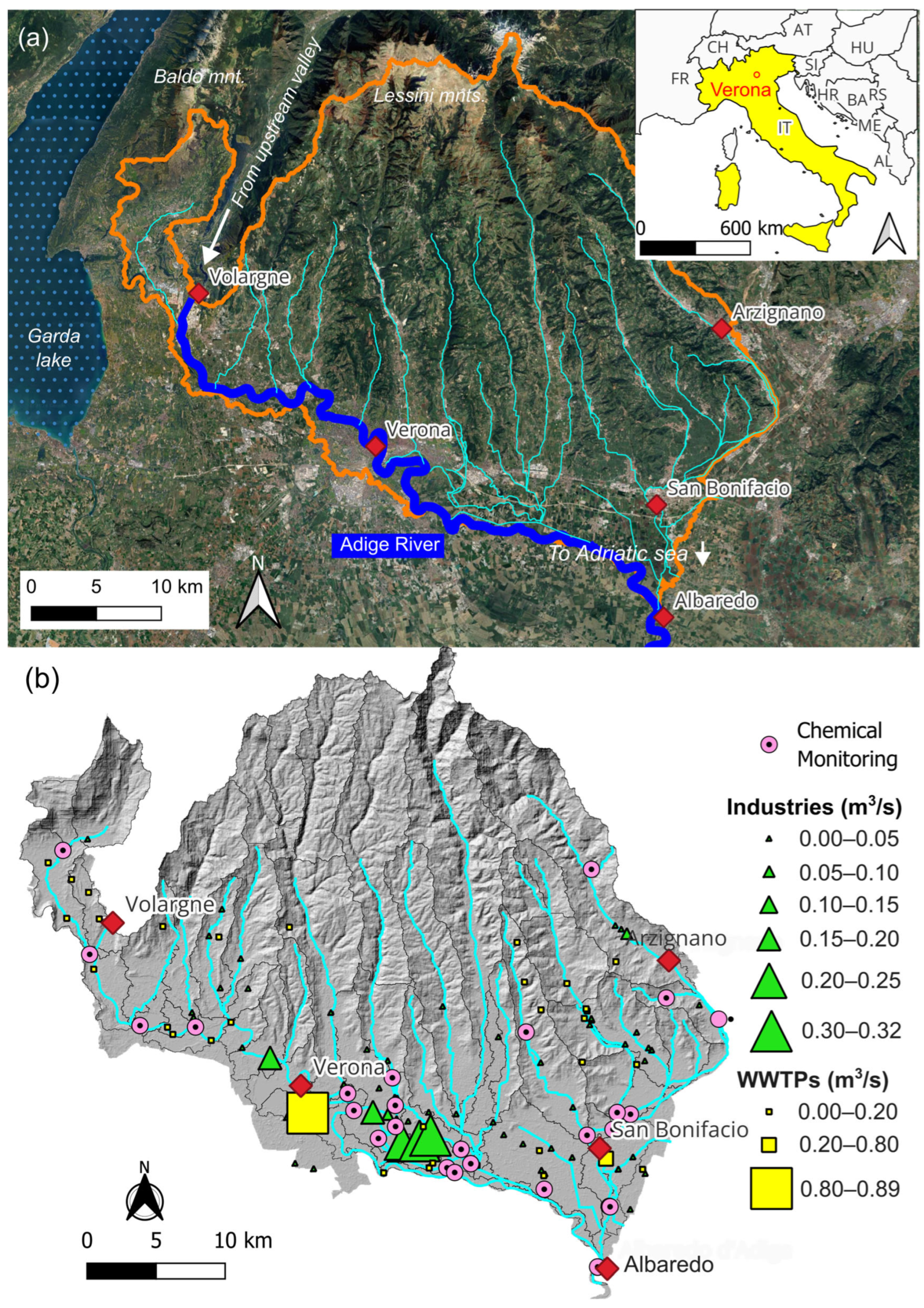
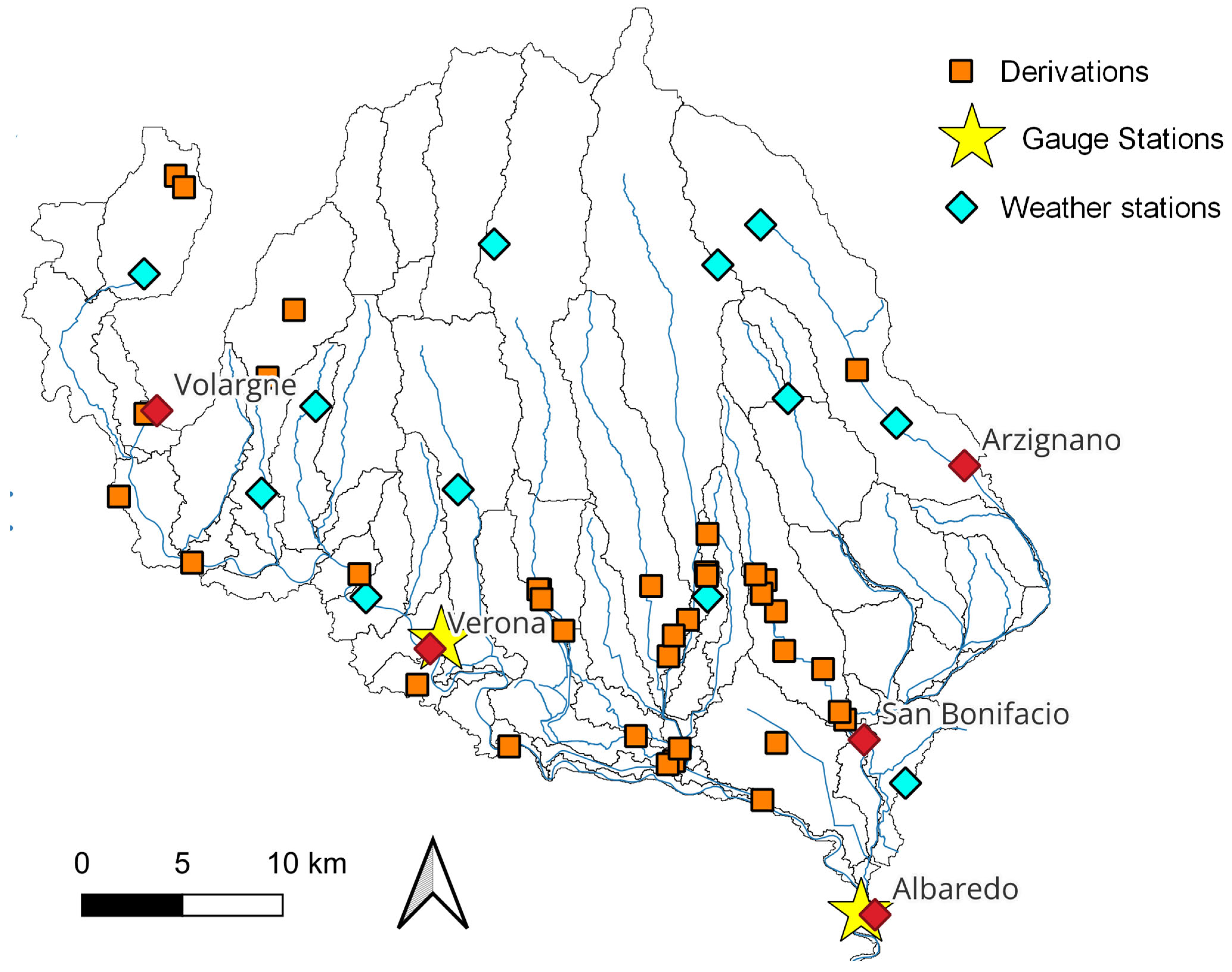


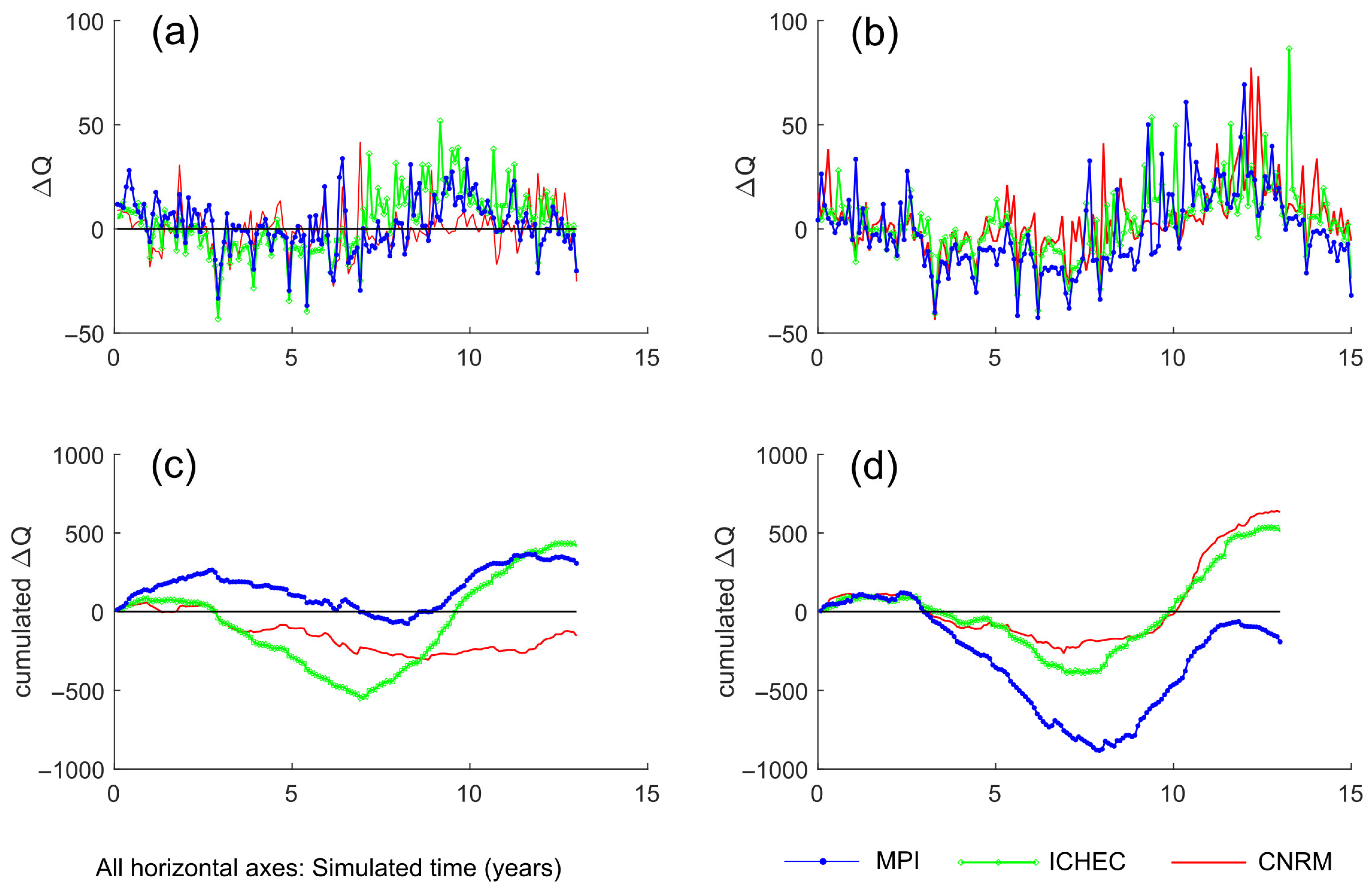
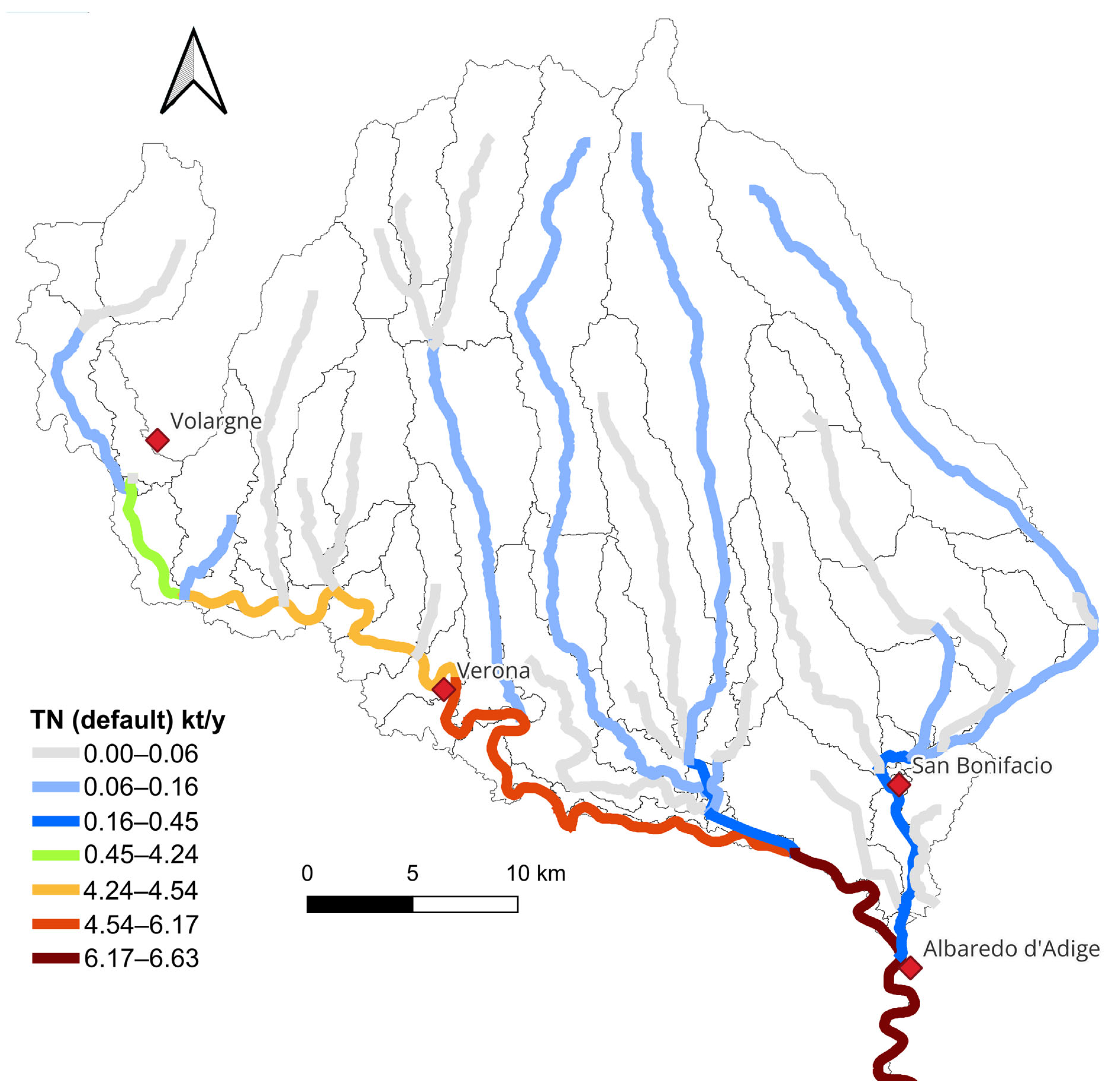
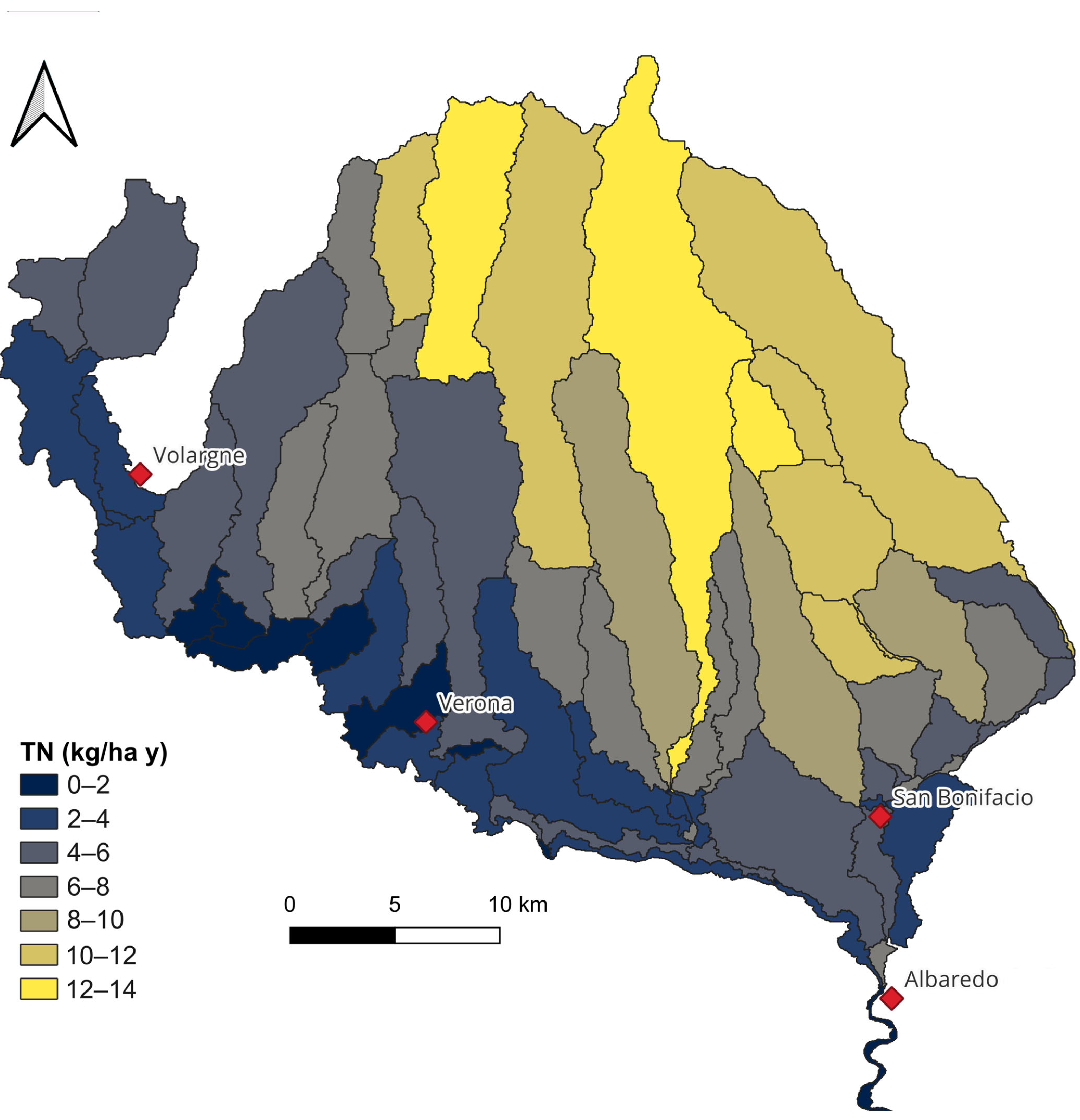

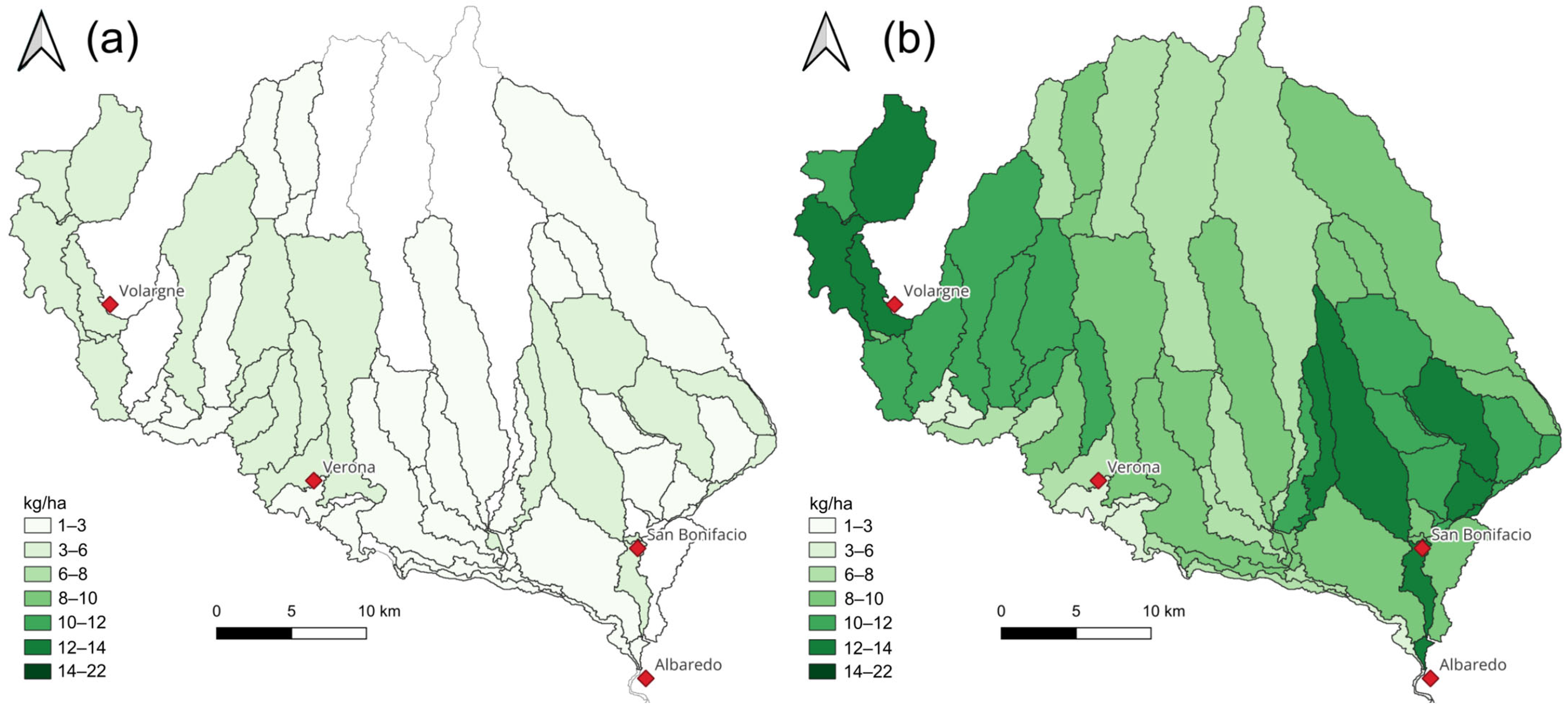
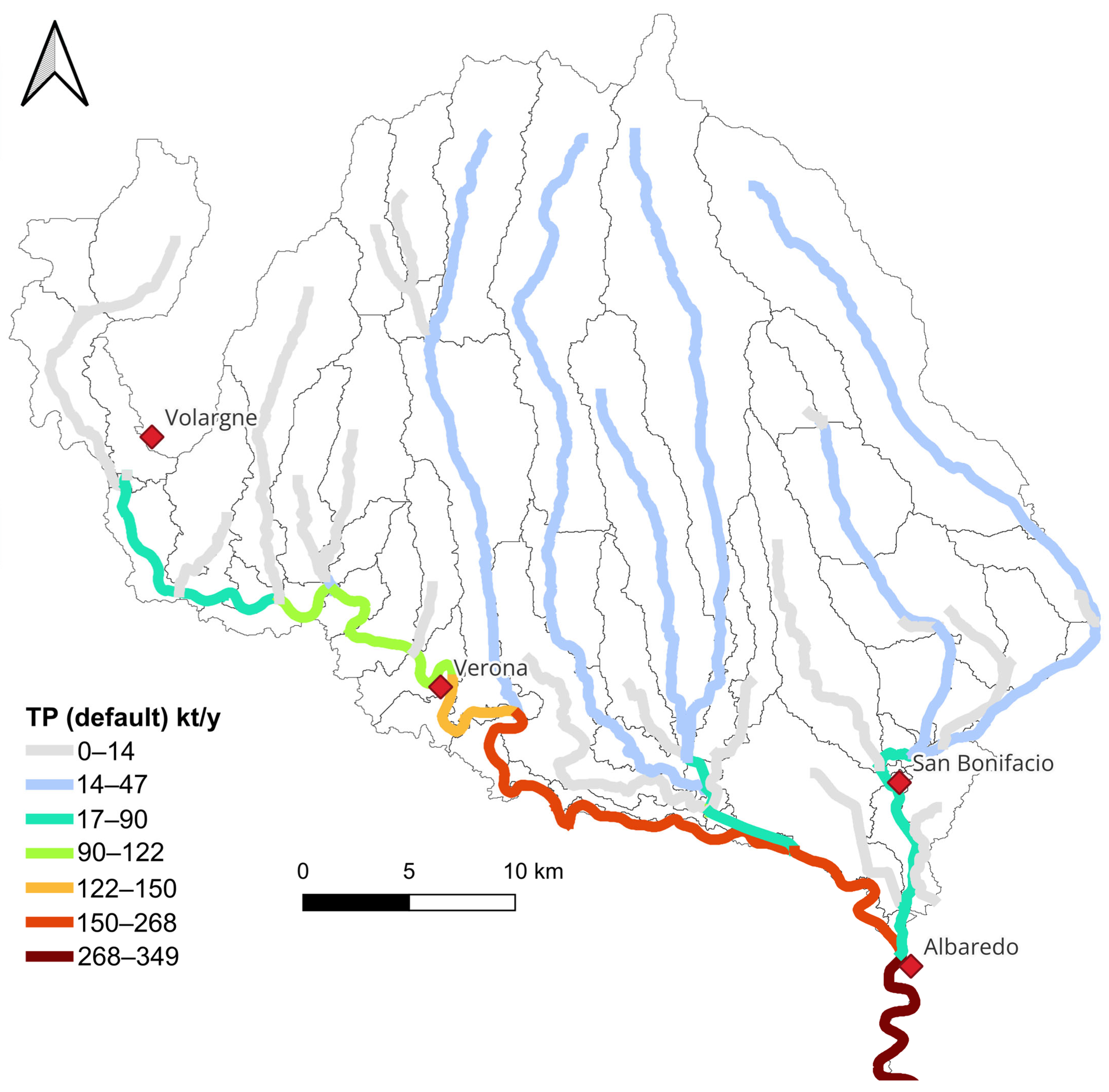
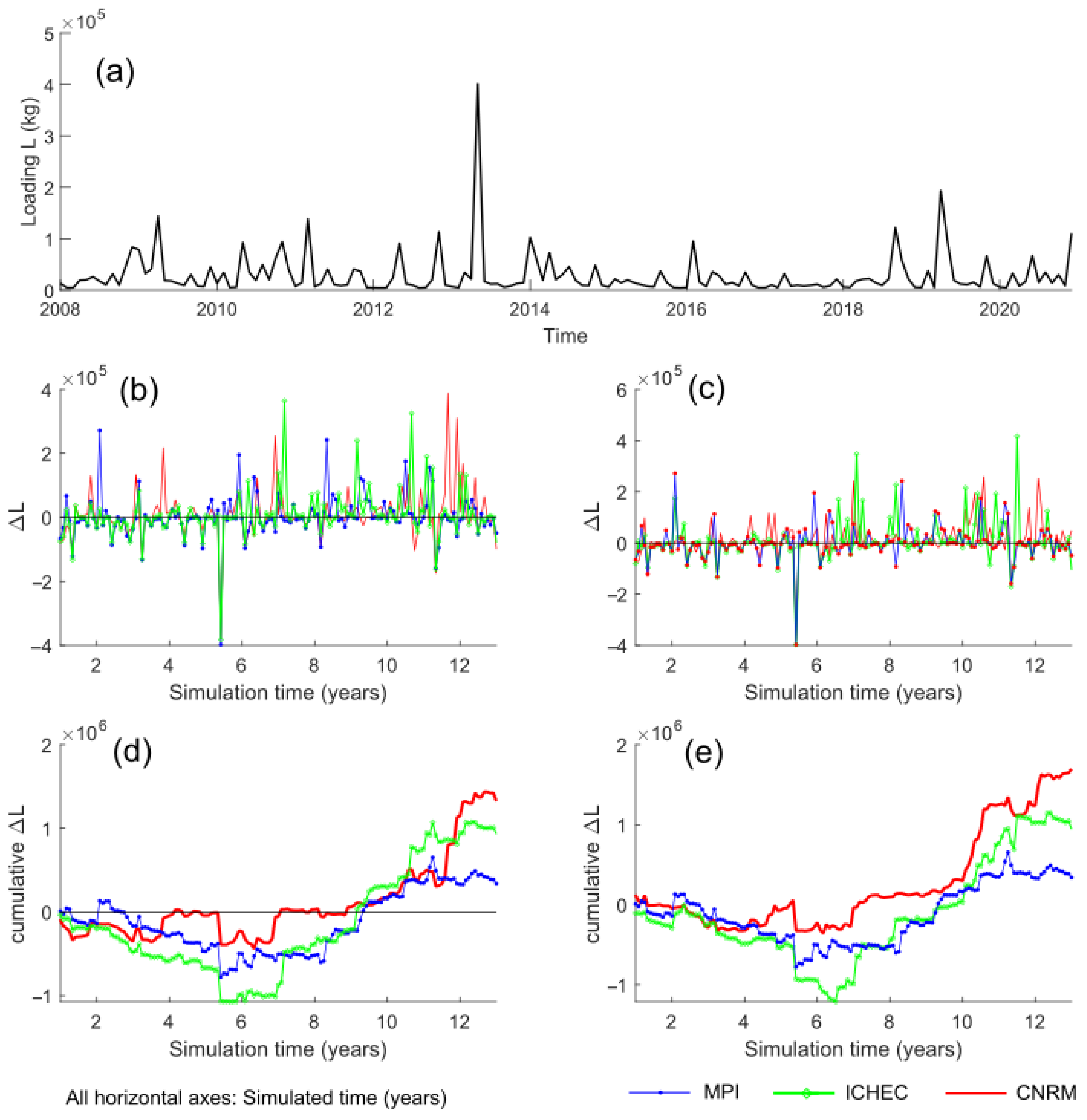

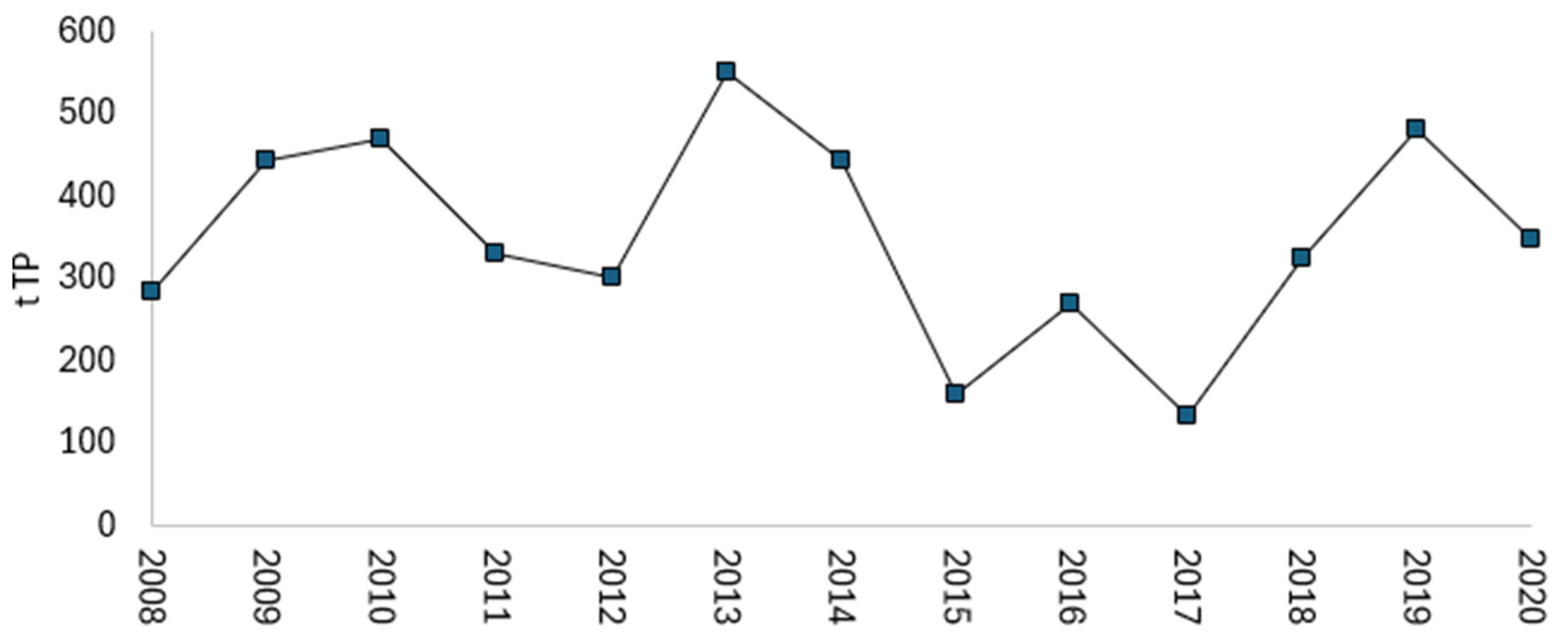

| Crop Type (Weight) Sowing (S); Harvesting (H) | Fertilizer Application Date | Fertilizer ID | Dosage (kg/ha) | N (kg/ha) | P (kg/ha) |
|---|---|---|---|---|---|
| Barley—inorganic (40%) S:15-Nov; H:20-Jun | 15-Oct | 06-24-24 | 300 | 18 | 31 |
| 20-Feb | 33-00-00 | 130 | 43 | 0 | |
| 20-Mar | Urea | 150 | 69 | 0 | |
| Barley—organic (60%) S:15-Nov; H:20-Jun | 10-Oct | DFM | n.a. | 105 | 18 |
| 10-Mar | 33-00-00 | 130 | 43 | 0 | |
| Wheat—inorganic (40%) S:10-Apr; H:15-Nov | 15-oct | 06-24-24 | 300 | 18 | 31 |
| 20-Feb | 33-00-00 | 185 | 61 | 0 | |
| 20-Apr | Urea | 142 | 65 | 0 | |
| Wheat—organic (60%) S:10-Apr; H:15-Nov | 10-Oct | DFM | n.a. | 91 | 16 |
| 20-Mar | 33-00-00 | 250 | 83 | 0 | |
| Appletree—inorganic (100%) S:15-Mar; H:20-Sept | 20-Mar | 21-0-0 | 200 | 42 | 0 |
| 2-Jul | 13-0-46 | 150 | 20 | 0 | |
| 20-Oct | 12-6-18 | 200 | 24 | 5 | |
| Grassland—organic (100%) | 15-Mar | DFM | n.a. | 300 | 52 |
| Maize—inorganic (28%) S:10-Apr; H:15-Nov | 20-Apr | 06-24-24 | 500 | 30 | 52 |
| 15-May | Urea | 250 | 115 | 0 | |
| 10-Jun | Urea | 210 | 97 | 0 | |
| Maize—organic (72%) S:10-Apr; H:15-Nov | 10-Mar | DFM | n.a. | 157 | 27 |
| 10-Jun | Urea | 260 | 119 | 0 | |
| Olive trees—inorganic (30%) S:1-Mar; H:1-Nov | 1-Mar | 20-10-10 | 150 | 30 | 6 |
| 2-May | Urea | 100 | 46 | 0 | |
| Pastures—organic (100%) | 1-Apr | DFM | n.a. | 170 | 30 |
| Potato—inorganic (34%) S:27-Mar; H:1-Aug | 15-Mar | 05-10-15 | 835 | 42 | 36 |
| 20-Apr | Urea | 150 | 69 | 0 | |
| 10-May | Urea | 140 | 64 | 0 | |
| Potato—organic (66%) S:27-Mar; H:1-Aug | 15-Mar | DFM | n.a. | 179 | 31 |
| 20-Apr | 12-08-18 | 100 | 12 | 3 | |
| 10-May | Urea | 140 | 64 | 0 | |
| Rapeseed—inorganic (34%) S:30-Sep; H:25-Jun | 20-Feb | 15-15-15 | 410 | 62 | 27 |
| 20-Mar | 33-00-00 | 250 | 83 | 0 | |
| Rapeseed—organic (66%) S:30-Sep; H:25-Jun | 15-Sep | DFM | n.a. | 99 | 17 |
| 20-Feb | 15-15-15 | 150 | 23 | 2 | |
| 20-Mar | 33-00-00 | 200 | 66 | 0 | |
| Soy—inorganic (100%) S:30-Apr; H:5-Oct | 20-Apr | 0-26-00 | 200 | 0 | 23 |
| 20-Apr | Urea | 65 | 30 | 0 | |
| Sugar beet—inorganic (43%) S:30-Apr; H:25-Jun | 20-Feb | Urea | 130 | 60 | 0 |
| 20-Feb | 18-46-00 | 150 | 27 | 30 | |
| 15-Apr | 33-00-00 | 200 | 66 | 0 | |
| Sugar beet—organic (57%) S:30-Apr; H:25-Jun | 20-Feb | DFM | n.a. | 86 | 15 |
| 15-Apr | Urea | 230 | 106 | 0 | |
| Sunflowers—inorganic (35%) S: 10-Apr; H: 30-Aug | 1-Apr | 0-15-0 | 150 | 0 | 10 |
| 1-Apr | 28-10-10 | 150 | 42 | 6 | |
| 20-May | Urea | 150 | 69 | 0 | |
| Sunflowers—organic (65%) S: 10-Apr; H: 30-Aug | 1-Apr | DFM | 0 | 84 | 15 |
| 20-May | Urea | 145 | 67 | 0 | |
| Grape—inorganic (89%) S:15-Mar; H:1-Sep | 30-Mar | 21-00-00 | 150 | 32 | 0 |
| 2-Jun | 27-0-0 | 100 | 27 | 0 | |
| 20-Oct | 06-08-15 | 400 | 24 | 14 | |
| Grape—organic (89%) S:15-Mar; H:1-Sep | 30-Mar | 21-00-00 | 150 | 32 | 0 |
| 2-Jun | 27-0-0 | 100 | 27 | 0 | |
| 20-Oct | DFM | 0 | 30 | 5 |
| Parameter Name | Description | Units | Min | Max | Calibrated |
|---|---|---|---|---|---|
| r__CN2.mgt | Moisture condition II curve number | - | −0.50 | 0.50 | −0.30 |
| v__ALPHA_BF.gw | Baseflow recession constant | - | 0.00 | 1.00 | 0.71 |
| v__GW_DELAY.gw | Delay time for groundwater recharge | d | 30.00 | 450.00 | 433.62 |
| v__GWQMN.gw | Threshold depth of water in the shallow aquifer required for return flow to occur | mm H2O | 0.00 | 2.00 | 0.92 |
| v__GW_REVAP.gw | Groundwater revap coefficient | - | 0.00 | 0.20 | 0.14 |
| v__ESCO.hru | Soil evaporation compensation factor | - | 0.80 | 1.00 | 0.82 |
| v__CH_N2.rte | Manning’s coefficient tributary channels | - | 0.00 | 0.30 | 0.14 |
| v__CH_K2.rte | Hydraulic conductivity of riverbed | mm hr−1 | 5.00 | 130.00 | 10.88 |
| v__ALPHA_BNK.rte | Bank flow recession constant | - | 0.00 | 1.00 | 0.78 |
| r__SOL_AWC(1).sol | Soil available water capacity | - | −0.20 | 0.40 | 0.38 |
| r__SOL_K(1).sol | Saturated hydraulic conductivity | mm hr−1 | −0.80 | 0.80 | −0.49 |
| r__SOL_BD(1).sol | Moist bulk density | g cm−3 | −0.50 | 0.60 | −0.48 |
| v__SFTMP.bsn | Snowfall temperature | °C | −10.00 | 10.00 | −5.10 |
| r__OV_N.hru | Manning’s coefficient | [-] | −0.20 | 0.20 | 0.17 |
| r__HRU_SLP.hru | Slope length | m | 0.00 | 0.50 | 0.05 |
| r__SLSUBBSN.hru | Average slope length | m | 0.00 | 0.50 | 0.28 |
| GCM | RCM | GWL 2 °C | GWL 3 °C |
|---|---|---|---|
| Corresponding period | |||
| CNRM-CM5 | ICTP RegCM4-6 | 2035–2052 | 2057–2076 |
| ICHEC-EARTH | ICTP RegCM4-6 | 2024–2043 | 2050–2069 |
| MPI-ESM-LR | ICTP RegCM4-6 | 2027–2046 | 2051–2070 |
| Summary Statistics | Short Description | Albaredo | Verona |
|---|---|---|---|
| NSE | Nash Sutcliffe error [-] | 0.76 | 0.69 |
| p-factor | Percentage of values within the 95% interval [-] | 0.63 | 0.28 |
| r-factor | 95% envelop thickness [-] | 0.54 | 0.10 |
| R2 | Coefficient of determination [-] | 0.85 | 0.89 |
| bR2 | Modified R2 [-] | 0.84 | 0.70 |
| MSE | Mean square error [m6/s2] | 2400.00 | 1900.00 |
| SSQR | Ranked square errors [m6/s2] | 860.00 | 1200.00 |
| PBIAS | Percent bias [-] | 12.00 | −11.80 |
| KGE | Kling-Gupta efficiency [-] | 0.84 | 0.63 |
| RSR | Standardized RMSE [m3/s] | 0.49 | 0.56 |
| MNS | Modified Nash Sutcliffe coefficient [-] | 0.50 | 0.46 |
| VOL_FR | fraction of the overall water balance that is predicted [-] | 1.14 | 0.89 |
| Mean sim (Mean obs) | Average simulated (observed) values [m3/s] | 192.16 (218.31) | 156.65 (140.11) |
| Std Dev sim (Std Dev obs) | Standard deviation of the simulated (observed) values [m3/s] | 106.79 (99.92) | 104.01 (77.30) |
| Model | Scenario | Jan | Feb | Mar | Apr | May | Jun | Jul | Aug | Sep | Oct | Nov | Dec |
|---|---|---|---|---|---|---|---|---|---|---|---|---|---|
| CNRM | Control | 57.5 | 73.7 | 75.8 | 93.5 | 118.8 | 86.1 | 83.7 | 95.8 | 96.8 | 104.5 | 136.1 | 81.6 |
| GWL = 2 C | 71.2 | 84.8 | 58.3 | 116.3 | 115.3 | 77.6 | 89.5 | 116.5 | 93.5 | 115.5 | 208.4 | 71.1 | |
| GWL = 3 C | 92.8 | 79.2 | 72.3 | 112.0 | 119.1 | 94.4 | 91.1 | 105.0 | 115.2 | 103.2 | 167.5 | 94.2 | |
| ICHEC | Control | 57.5 | 73.7 | 75.8 | 93.5 | 118.8 | 86.1 | 83.7 | 95.8 | 96.8 | 104.5 | 136.1 | 81.6 |
| GWL = 2 C | 86.0 | 117.7 | 111.4 | 73.0 | 86.5 | 83.2 | 74.9 | 114.7 | 83.6 | 89.7 | 100.6 | 85.5 | |
| GWL = 3 C | 108.3 | 102.8 | 108.1 | 106.3 | 96.8 | 90.1 | 127.5 | 82.1 | 94.5 | 89.3 | 97.9 | 122.1 | |
| MPI | Control | 57.5 | 73.7 | 75.8 | 93.5 | 118.8 | 86.1 | 83.7 | 95.8 | 96.8 | 104.5 | 136.1 | 81.6 |
| GWL = 2 C | 41.5 | 66.5 | 84.1 | 95.6 | 139.5 | 106.5 | 74.2 | 108.2 | 98.9 | 123.3 | 109.8 | 68.8 | |
| GWL = 3 C | 59.0 | 86.1 | 83.6 | 114.0 | 142.6 | 104.3 | 64.6 | 73.6 | 115.0 | 167.6 | 167.3 | 57.6 | |
| Reference | 58.2 | 74.1 | 76.1 | 93.9 | 119.2 | 86.6 | 84.2 | 96.3 | 97.2 | 105.3 | 136.7 | 82.5 | |
Disclaimer/Publisher’s Note: The statements, opinions and data contained in all publications are solely those of the individual author(s) and contributor(s) and not of MDPI and/or the editor(s). MDPI and/or the editor(s) disclaim responsibility for any injury to people or property resulting from any ideas, methods, instructions or products referred to in the content. |
© 2025 by the authors. Licensee MDPI, Basel, Switzerland. This article is an open access article distributed under the terms and conditions of the Creative Commons Attribution (CC BY) license (https://creativecommons.org/licenses/by/4.0/).
Share and Cite
Pedretti, D.; Camera, C.A.S.; Libera, N.D.; Pasini, S.; Gelmini, Y.; Braidot, A. High-Resolution Flow and Nutrient Modeling Under Climate Change in the Flat, Urbanized and Intensively Cultivated Adige River Lowland Basin (Italy) Using SWAT. Hydrology 2025, 12, 239. https://doi.org/10.3390/hydrology12090239
Pedretti D, Camera CAS, Libera ND, Pasini S, Gelmini Y, Braidot A. High-Resolution Flow and Nutrient Modeling Under Climate Change in the Flat, Urbanized and Intensively Cultivated Adige River Lowland Basin (Italy) Using SWAT. Hydrology. 2025; 12(9):239. https://doi.org/10.3390/hydrology12090239
Chicago/Turabian StylePedretti, Daniele, Corrado A. S. Camera, Nico Dalla Libera, Sara Pasini, Ylenia Gelmini, and Andrea Braidot. 2025. "High-Resolution Flow and Nutrient Modeling Under Climate Change in the Flat, Urbanized and Intensively Cultivated Adige River Lowland Basin (Italy) Using SWAT" Hydrology 12, no. 9: 239. https://doi.org/10.3390/hydrology12090239
APA StylePedretti, D., Camera, C. A. S., Libera, N. D., Pasini, S., Gelmini, Y., & Braidot, A. (2025). High-Resolution Flow and Nutrient Modeling Under Climate Change in the Flat, Urbanized and Intensively Cultivated Adige River Lowland Basin (Italy) Using SWAT. Hydrology, 12(9), 239. https://doi.org/10.3390/hydrology12090239








